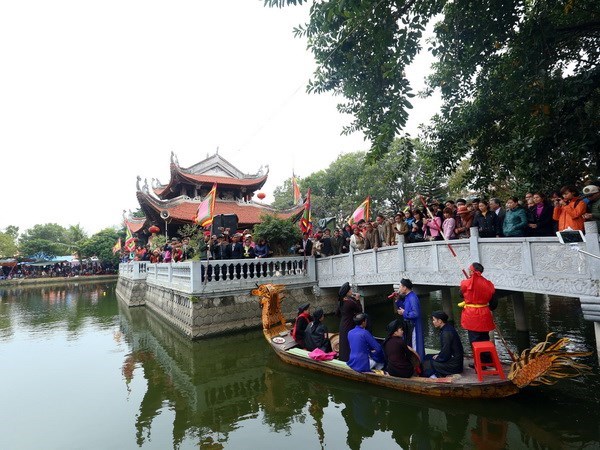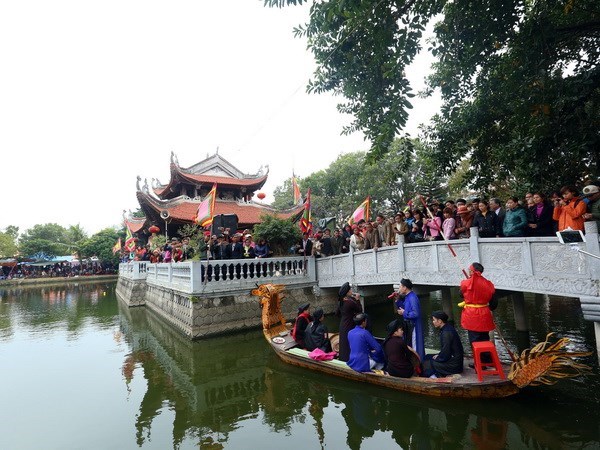
Thousands of local people and visitors have flocked to Tien Du district in the northern province of Bac Ninh to attend the Lim festival, which honours Quan Ho (love duet singing) – the world intangible cultural heritage recognised by UNESCO.

Quan Ho is
performed on boats - Illustrative image (Source: VNA)
The annual festival takes place on February 27-28 or the 12th and
13th days of the Lunar New Year.
The incense-offering rituals were organised at Hong An pagoda (Lim pagoda) on
Lim Hill. The pagoda is dedicated to Nguyen Dinh Dien (Hieu Trung Hau),
who invented Quan Ho.
The Lim festival contributes to preserving the locality’s traditional cultural
values and promoting images and tourism potential of Bac Ninh.
The organising board has arranged six areas and one stage for Quan Ho singing.
Quan Ho is also performed on boats, and at pagodas and communal houses in Noi
Due and Lien Bao communes, and Lim town.
Besides Quan Ho singing, the festival also features various folk games such as
traditional wrestling, earthenware pot breaking, and bamboo swinging.
The art of love duets was inscribed in UNESCO’s representative list of intangible
cultural heritage in September 2009.
Quan Ho is an art form that combines various elements, including music,
lyrics and costumes, and features the distinctive culture of people in the
region formerly called Kinh Bac.
The singing represents different kinds of relationships -- the
relationship between male and female singers as romantic lovers, the
relationship between two friendly villages and the relationship between
performers and the audience. Each element helps define Quan Ho, give it
life and meaning, and the resulting harmony is so much more than just a
beautiful song.
Source: VNA
With an increasingly vibrant and widespread emulation movement aimed at building cultured residential areas and cultured families, Yen Thuy District has been making steady progress toward improving both the material and spiritual well-being of its people, while fostering a civilized, prosperous, beautiful, and progressive community.
Once lacking recreational spaces and community facilities, Residential Group 2 in Quynh Lam Ward (Hoa Binh City) has recently received attention for the construction of a new, spacious, and fully equipped cultural house. The project followed the model of state support combined with public contributions in both labor and funding.
The "All people unite to build cultural life" movement, which has been effectively integrated with Kim Boi district’s socio-economic development goals, is fostering a lively spirit of emulation across local residential areas, hamlets, villages, public agencies, and enterprises. In addition, through the initiative, traditional cultural values are being preserved and promoted, while community solidarity and mutual support in poverty reduction and economic development are being strengthened.
A working delegation of the Hoa Binh provincial People’s Committee led by its Permanent Vice Chairman Nguyen Van Toan on June 11 inspected the progress of a project to build the Mo Muong Cultural Heritage Conservation Space linked to tourism services in Hop Phong commune, Cao Phong district.
Born and growing in the heroic land of Muong Dong, Dinh Thi Kieu Dung, a resident in Bo town of Kim Boi district, in her childhood was nurtured by the sweet lullabies of her grandmother and mother. These melodies deeply imprinted on her soul, becoming an inseparable part of her love for her ethnic group's culture. For over 20 years, this love for her hometown has driven Dung to research, collect, and pass down the cultural values of the Muong people to future generations.
In the final days of May, the Ethnic Art Troupe of Hoa Binh Province organized performances to serve the people in remote, mountainous, and particularly disadvantaged areas within the province. These were not just ordinary artistic shows, but they were the meaningful journeys aimed at spreading cultural values, enhancing the spiritual life of the people and contributing to the preservation of ethnic minority cultural identities.



